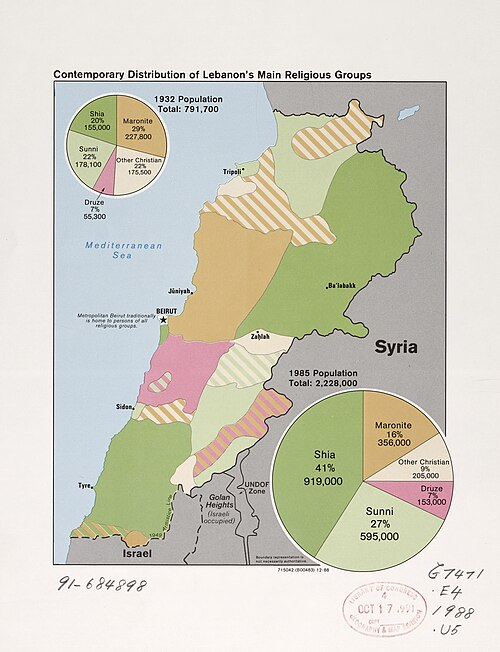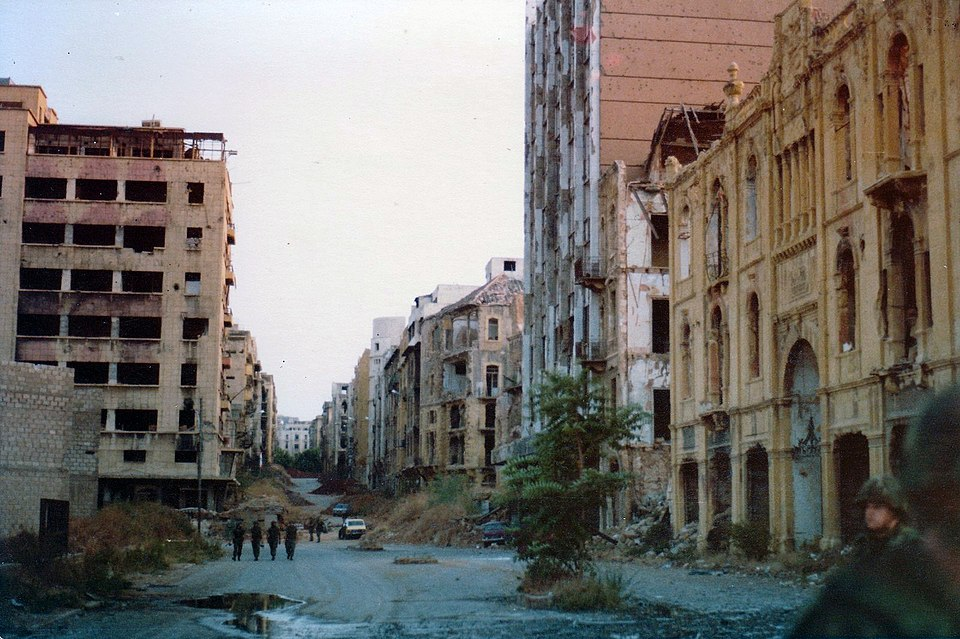IB Syllabus focus:
'Investigate the complex history of Lebanon, including its civil wars, outside interference, and efforts at reconstruction.
Explore the concept of the Confessional state; economic, religious, and social tensions; and the growth of militias and the PLO.'
Lebanon’s history from 1945 to 2000 is a compelling narrative of resilience against a backdrop of multiple conflicts, social upheavals, and external interventions. This period in Lebanese history is deeply intertwined with the broader Middle Eastern politics, religious divides, and the struggle for national identity and stability.
Confessional State: Structure and Tensions
Defining the Confessional System
Lebanon’s National Pact of 1943 formalised a confessional system allocating power among the major religious sects.
The President is a Maronite Christian, the Prime Minister a Sunni Muslim, and the Speaker of the Parliament a Shia Muslim.
Governance Challenges
Political power is often exercised through sectarian allegiances, leading to claims of nepotism and corruption.
The demographic balance has shifted over time, leading to calls for political reform.

This 1988 map produced by the U.S. government depicts the contemporary distribution of Lebanon’s main religious communities, illustrating why demographic change intensified debates about power-sharing under the confessional system. The two small statistical insets provide additional detail not required by the syllabus. Source
Economic Disparities
Regional disparities and favouritism have led to economic inequality, fostering social unrest.
The reliance on sectarian networks for social services has entrenched divisions and hindered national cohesion.
Lebanese Civil Wars: 1975-1990
Origins and Escalation
Initial skirmishes between the Phalangist (predominantly Maronite) militia and Palestinian factions escalated into full-scale civil war.

View along Beirut’s “Green Line” (1982), the wartime demarcation that separated predominantly Christian East Beirut from predominantly Muslim West Beirut and left buildings along the corridor badly damaged. The image conveys how frontlines hardened as the conflict intensified. Source
Intervention by neighbouring states, each backing different factions, turned Lebanon into a proxy warzone.
Major Events and Turning Points
The 1976 Syrian intervention stabilised certain regions but also solidified Syrian influence over Lebanon.
The 1982 Israeli invasion sought to eliminate PLO forces, leading to the Siege of Beirut and international condemnation.
Impact on Lebanese Society
An estimated 120,000 fatalities, with thousands missing and widespread displacement.
Infrastructure and basic services were decimated, severely impeding post-war recovery.
External Influences: Regional and International
Palestinian Liberation Organization (PLO)
The PLO’s military presence and activities against Israel from Lebanese territory were a major catalyst for conflict.
Their influence waned post-1982 as they were forced to relocate their base to Tunisia.
Syrian and Israeli Occupations
Both countries maintained military presences at different times, shaping Lebanon’s political landscape.
Their eventual withdrawals were significant in allowing Lebanon to pursue a more independent path.
Militias and Political Organisations
Rise of Militias
Various militias emerged, often aligned with religious or ethnic identities, becoming powerful political players.
Hezbollah’s rise in the 1980s, backed by Iran, became a defining aspect of Lebanese politics and its stance against Israel.
Political Parties
Traditional political parties often had armed wings, blurring lines between political and military influence.
The post-war era saw the transformation of some militias into legitimate political parties.
Reconstruction and Development
Infrastructure Rebuilding
Reconstruction focused on Beirut's central district, although criticised for elitism and poor urban planning.
International aid and investment were crucial but also led to increasing public debt.
Social Development
Efforts were made to repair the social fabric of Lebanon through education and community initiatives.
Despite these, sectarian divides persisted, affecting daily life and governance.
The Taif Agreement and Political Reformation
The Taif Agreement (1989)
Aimed to end the civil war and redistribute political power to provide a more equitable system.
While officially ending the conflict, the agreement did not address all underlying issues.
Post-Taif Politics
Subsequent governments have struggled to maintain stability and enact reforms promised in Taif.
Political assassinations, like that of Prime Minister Rafik Hariri in 2005, have periodically destabilised the country.
Lebanese Civil Society and Peacemaking Efforts
Civil Society Initiatives
NGOs and community groups have worked to bridge sectarian divides and provide services where the government cannot.
Civil society has been a driving force in promoting dialogue and reconciliation.
International and Regional Peacemaking
The UN and the Arab League have played roles in mediating and peacekeeping, with varying degrees of success.
The 2000 Camp David Summit, although primarily focused on Israeli-Palestinian peace, had implications for Lebanese security.
Conclusion
These study notes capture the multifaceted history of Lebanon from 1945 to 2000. This period is marked by the nation's grappling with its unique confessional political system, repeated external interventions, and civil wars. Lebanon's experiences reflect the complexities of balancing internal diversity with external pressures and are crucial for understanding Middle Eastern dynamics in the latter half of the twentieth century. Understanding Lebanon’s past is not just about recounting conflicts and political changes; it is about appreciating the ongoing quest for peace and stability in a nation that epitomises the rich mosaic of Middle Eastern society.
FAQ
The Taif Agreement aimed to address the disproportionate political power distributed under the confessional system. It reduced the Christian majority in Parliament and increased Muslim representation, reflecting more accurately the demographic changes. The agreement also weakened the Maronite President’s power, distributing it more equally among the Sunni Prime Minister and Shia Speaker of the Parliament. Although this helped end the civil war, the alterations led to new challenges, as power became even more decentralised and fragmented, often paralysing decision-making processes and perpetuating a cycle of political patronage and sectarian politics that continued to destabilise Lebanon.
Lebanon’s banking secrecy laws, established in 1956, turned the country into an attractive financial hub, particularly for Arab investors. The influx of capital boosted the economy, contributing to a period known as the "Golden Age" prior to the civil war. However, this financial boon also led to stark inequalities, which, coupled with the confessional system, contributed to social unrest. These laws later hindered efforts to address corruption and recover state assets, post-war. The secrecy shielded the misappropriation of funds and allowed for money laundering, deepening socio-economic divides and impeding effective governance and economic recovery.
The presence of Palestinian refugees, who fled to Lebanon due to the Arab-Israeli conflict, significantly contributed to internal tensions. Their arrival upset the delicate demographic and political balance maintained by the confessional system. Palestinians often faced discrimination and had limited rights, leading to socio-economic disenfranchisement. Their support for the PLO, and the PLO's subsequent armed presence in southern Lebanon, became a contentious issue, especially among Lebanese factions opposed to the Palestinians' political and militant activities. This contributed to the Lebanese Civil War's ignition, with the PLO and its allies on one side and Lebanese Christian militias on the other.
The Lebanese diaspora played a significant role during and after the civil war, both politically and economically. During the war, various diaspora communities provided financial support to different factions and militias. After the war, they were a major source of remittances, which became a critical component of Lebanon's economy, accounting for a significant portion of the GDP. Politically, the diaspora exerted influence through their financial contributions and lobbying efforts. They have also been involved in promoting international awareness and aid for Lebanon, and in some cases, members of the diaspora have returned to Lebanon and engaged directly in politics, business, and civil society.
The 1990s reconstruction in Lebanon, led by Prime Minister Rafik Hariri, focused predominantly on Beirut, especially its central district, aiming to restore its pre-war glamour and economic vitality. This effort was criticised for exacerbating regional disparities as the rural areas and peripheral cities remained neglected. The Beirut-centric redevelopment favoured the elite and investors, often at the expense of the lower socio-economic groups, which led to increased inequality and social dissatisfaction. Additionally, the neglect of other regions compounded feelings of marginalisation and hindered the development of a cohesive national identity, further straining Lebanon's fragile post-war recovery.
Practice Questions
The external powers, notably Syria and Israel, played pivotal roles in the Lebanese Civil War. Syria's intervention in 1976 under the guise of a peacekeeping force established its dominance and influenced Lebanon’s political structure significantly. Israel's invasion in 1982 aimed at ousting the PLO from Lebanon, led to the PLO's relocation and influenced the trajectory of the conflict. An excellent student would recognise that while these interventions were meant to secure each nation's interests, they inadvertently prolonged the conflict, complicated internal dynamics, and led to a heavier toll on the Lebanese populace.
Lebanon's confessional system, intended to maintain peace by distributing power among its religious sects, had mixed outcomes. It provided a framework for political representation but also entrenched sectarian divisions, leading to political gridlock and patronage. This system, while promoting inclusivity, often became a source of tension, as demographic changes led to disproportional representation. Stability was thus frequently undermined as sectarian leaders wielded power to benefit their constituents over national unity. The excellent student would identify that the system's rigidity and inability to adapt effectively to changing demographics and political landscapes was a key factor in Lebanon's instability.

